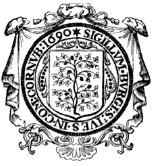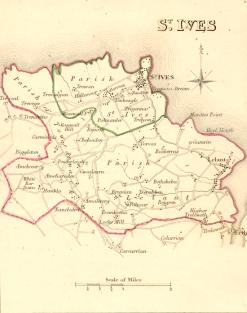The following is from [Lewis 1831] and must be read in the context of that date.

Seal and Arms
IVES (ST), a borough, sea-port, market town, and possessing separate jurisdiction, though locally in the hundred of Penwith, county of Cornwall, 8 miles (N.E. by N.) from Penzance, and 278 (W.S.W.) from London, containing 3596 inhabitants. The ancient name of this place was Porth-Ia, derived from St. Hya, or Ia, the daughter of an Irish chieftain, who, about the middle of the fifth century, visiting Cornwall with some Christian missionaries, died and was buried here, and being afterwards canonized, the parish church was originally dedicated to her. In the beginning of the reign of Edward VI., the portreeve of this town, whose name was Payne, was hanged, by order of the Provost-marshal, Sir Anthony Kingston, on account of having been engaged in the rebellion under Humphrey Arundel, the governor of St. Michael’s Mount. The town is situated on the western side of a bay to which it gives name, and which opens to the Bristol channel. At the entrance to it from Redruth most of the houses are well built and roofed with slate; but in the lower part of the town the streets are narrow and uneven; they are not lighted, nor regularly paved, but there is a good supply of water. The general appearance is mean, except when viewed from the surrounding heights, whence the prospect is extremely picturesque. A good pier was erected for the improvement of the harbour, in 1770, by Mr. Smeaton, the builder of Eddystone lighthouse. The pier originally belonged to the corporation, who still receive a rent of £25 per annum from the proprietors of the new pier. This port, like most of those on the northern coast of the county, is incommoded by the constant accumulation of sand, driven in by the north-west winds; to prevent which it has been proposed to extend the pier, and construct a breakwater: the latter was commenced a few years ago, but was discontinued after an expenditure of about £5000. Ship-building and rope and sail-making are carried on here; but the trade depends chiefly on the neighbouring mines and fisheries the commercial imports consisting almost wholly of articles for the use of the miners and fishermen, and of their the exports being derived from the produce industry. The number of vessels which entered this port in 1826 was five British and six foreign, and the number that cleared outwards was twelve British and foreign: the number of vessels belonging to the port in 1828, was, seven of more than one hundred tons burden, and seventy-seven below that rate. By means of this shipping, commercial intercourse is extensively maintained with the merchants of Bristol, to whom is consigned the produce of the neighbouring mines by agents residing at St. Ives. Off the coast the pilchard fishery is carried on upon a very large scale and during the season, which lasts from July till the end of November, in some years, the quantity of fish taken and cured has been sufficient to fill three thousand five hundred hogsheads, which are chiefly exported to Italy, and other parts bordering on the Mediterranean. The valleys in the vicinity of the town are watered by small streams, the currents of which work the machinery used in preparing for the market copper and tin ores, and they also turn several corn-mills. On a peninsular promontory extending northwards from the town was formerly a light-house, now used for preserving government store; and near it is a battery for the defence of the harbour. Markets are held by charter on Wednesday and Saturday, but that on the former day is inconsiderable: there were anciently four fairs, but those only deserving notice are, on the 29th of May and the Saturday before Advent Sunday. The town is said to have been anciently governed by a portreeve: It was first incorporated by a charter dated in the 16th of Charles I., and under a subsequent charter granted by James II., in 1685, the corporation consists of a mayor, recorder, ten aldermen (exclusively of the mayor), and an unlimited number of common council-men, with a town-clerk and other officers. The mayor as elected by a majority of the aldermen and assistants, or common council-men, from two persons nominated by the aldermen, who are chosen by their own body from the assistants, and the latter by the mayor, recorder, and aldermen: the recorder is elected by the aldermen, who also form a select vestry and manage the affairs of the parish. The mayor, the late mayor, the recorder, and the senior alderman, are justices of the peace, and hold quarterly courts of session for misdemeanors committed within the borough. No courts of record are now held, though it appears the justices have power to take cognizance of suits for sums to an unlimited amount: courts baron for the manor are held annually. The borough has sent members to parliament since the 5th of Philip and Mary: the right of election Is vested in inhabitants paying scot and lot, between three and four hundred in number; and the mayor is the returning officer: the patronage of the borough belongs to the Marquis of Cleveland.

St. Ives Parish and Borough
The living is a perpetual curacy, annexed to the vicarage of Uny Lelant, in the archdeaconry of Cornwall, and diocese of Exeter, endowed with £2000 four per cents., royal bounty. The church, dedicated to St. Andrew, is a handsome edifice with a lofty tower, erected as a chancel of ease to Uny Lelant, In the early part of the fifteenth century. Here are places of worship for the late Countess of Huntingdon’s Connexion, and for Wesleyan Methodists. An endowed grammar school was formerly established here, but the property belonging to it has been lost. There is a charity school for boys, which was founded and supported by the late Sir Christopher Hawkins, Bart. Almshouses for six poor widows were founded by Mrs. Cheston Hext, in 1649, which, having become ruinous, were sold by the corporation, and the produce applied to the building of a poor-house. A whimsical custom was established here by John Knill, Esq., a bencher of Grey’s Inn and some time collector for the port of St Ives, who died in 1811 he directed that, every five years, two old women, and ten girls under ten years old, dressed in white, should walk in procession, with music, from the market-house at St. Ives, to a pyramid which he erected on the summit of a lofty hill near the town, and which he designed for his burial-place; they were to dance round the pyramid, singing the hundredth psa1m; and for the purpose of keeping up this custom he gave an annuity charged on freehold lands, which are vested in the trust of the officiating minister, the mayor of St. Ives, and the collector, who are allowed £10 for a dinner. At St. Ives was born, in 1713, the Rev. Jonathan Toup, a celebrated critic, who published an edition of Longinus, and other learned works.